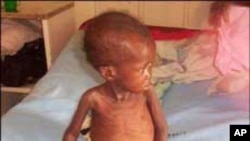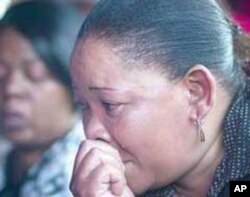The soft sound of slowly rolling drums wafts across a wasteland of yellow grass stubble. Screaming children push rough wire cars across the stony field, between the guide ropes of the big tent that’s been erected for guests.
There’s a funeral today in Silver City.
“I am Johanna’s mother,” says Masentle Mohajane,72. “My daughter was a huge person, with a huge heart. Johanna’s big voice could always be heard around here, singing.” Then, fighting back tears, the old woman smiles, “I can’t say she had the best voice on earth, but it always made me happy.”
Johanna Mohajane,40, is dead. She died alone, unconscious, lying in blood and vomit, in a crowded state hospital on the outskirts of Bloemfontein, the capital of South Africa’s Free State province.
Antiretroviral treatment (ART) could have saved her from the infections that finally killed her. But medical staff didn’t give it to her. “It was a pointless, needless death,” says Johanna’s sister, Elizabeth.
‘The right medicine….the right treatment’
She recalls how Johanna was admitted to hospital, too weak to move. “The nurses put her in a bed. We asked them what was wrong with her. They all said, ‘We don’t know anything.’ A few hours later, her face was covered in blood and mucous from her nose. Her mouth was black from lack of oxygen.”
“A drip that was meant to feed medicine into Johanna’s vein was blocked,” Elizabeth says.
Her mother adds, “We begged the doctors and nurses for help, but no one came, they were all too busy, the hospital is always full of sick and dying people.”
Within 24 hours, Johanna Mohajane was dead.
Her family blames the Free State health department. Bitter words pour from her mother’s mouth. “If (Johanna) [had been] given the right drip, the right medication, the right treatment, she would still be alive,” she states.
Last year, the government produced a National Strategic Plan aiming to cut new infections in half over the next two years. It also aims to provide treatment for opportunistic infections caused by HIV as well has psychological and nutritional counseling for those carrying the illness. ….
South Africa’s National Health Ministry acknowledges that the ARV roll-out is beset by problems.
National health minister Aaron Motsoaledi recently said that the South African government will not be able to meet its target of providing ARV treatment to 80 percent of HIV-infected people by 2011.
But the Free State government is adamant that it’s living up to its obligation to provide ARVs to all who need them and that it did not fail Johanna Mohajane.
TB and meningitis
According to Johanna’s government death certificate, she died of tuberculosis and meningitis – two diseases often associated with advanced HIV infection. She was also taking bactrim and ilvitrim – antibiotics commonly prescribed for HIV infection.
“They are telling us Johanna died of something else, not AIDS-related,” says her sister.
“Nurses at that hospital knew all along that Johanna had AIDS. They just never treated her, for whatever reason,” Elizabeth says.
Nurses at some clinics in Bloemfontein have told VOA that because of shortages of ARVs, the medications are sometimes rationed.
South African government guidelines say ARVs must be given immediately to those with severely weak immune systems, or a CD4 cell count of below 200. CD-4s are specialized cells that protect the body from infection. HIV attacks these cells and weakens the immune system, leading to the on-set of illnesses that a healthy immune system can withstand.
A healthy person’s CD4 cell count is about 500.
Sello Mokhalipi, a fieldworker for the Treatment Action Campaign, which wants ARVs for all South Africans who need them, says, “All over the Free State, I am seeing people with CD4 counts of less than 10. But they are not getting the drugs from state clinics. These people are dying of opportunistic infections.”
Recently, Nomathemba Gcuku,27, almost became one of these statistics. In the Phase 6 section of the massive Mangaung district, she hangs washing under a fiery sun, on a patchy lawn in front of her concrete-block home, which is wrapped in barbed wire. “To keep the criminals out,” she laughs, prodding her mangy pet dog out of her way with her foot.
A few months ago, feeling weak and close to death, Gcuku says she was forced to “beg” for help from a private doctor after clinics and hospitals “all across Bloemfontein” would not give her the free ARV medicine she needed to stay alive.
“November last year was the last time I got any medicine from the state,” she says. “I have watched other people around me die when they could not get drugs. It is inhumane.”
‘Fear not…. I am with thee’
Across the township, a tiny but spick-and-span house bakes in the afternoon sun. The house is in Freedom Square, a place where thousands of people live in poverty. Inside, Lerato Tsamai is cooking lunch for her brothers, aged 11 and 16. Music blares from two tall speakers. “Living on a thin line!” screams the song on the radio, “Tell me now, what are we supposed to do?”
Tsamai is 23, but looks more like 12. “The illness wasted me away,” she says, almost apologetically.
“I was sick earlier this year. I went to the clinic in Mangaung, and they were not able to put me on ARVs because they said, ‘Sorry, we have no drugs for new people; come back later."
She would return to the facility constantly for medicine, only to be sent home empty handed. “They kept on telling me, ‘Later, later….’” But later never came.
“I became so sick that I was admitted into a hospice,” Tsamai tells VOA. “I was dying. There, an NGO worker finally got me drugs, and my life was saved.” “I am with thee,” says the poster of a golden-haired Jesus hanging above her head. She closes her eyes and smiles.
Despite testimony such as that provided by the Mohajane family and people like Nomathemba Gcuku and Lerato Tsamai, provincial South African governments such as that in the Free State continue to deny the shortage or even the complete lack of ARVs in their jurisdictions.
Back in Silver City, Johanna Mohajane’s body lies in a coffin in a tiny room. Children play around it, oblivious to death. Elizabeth Mohajane can’t help but smile at the irony. “So much life,” she says, staring at the skipping children. “So much life…..”
Let us know what you think of this report and other news and features on our website. E-mail your views about what is happening in Africa to: africa@voanews.com. Please include your name and phone number if you would like us to include your comments on our programs.
You may also telephone us and leave a message. In the US, call: (202) 205-9942. After you hear the VOA greeting, press the number "30" and leave your message for potential use it our daily broadcasts.











